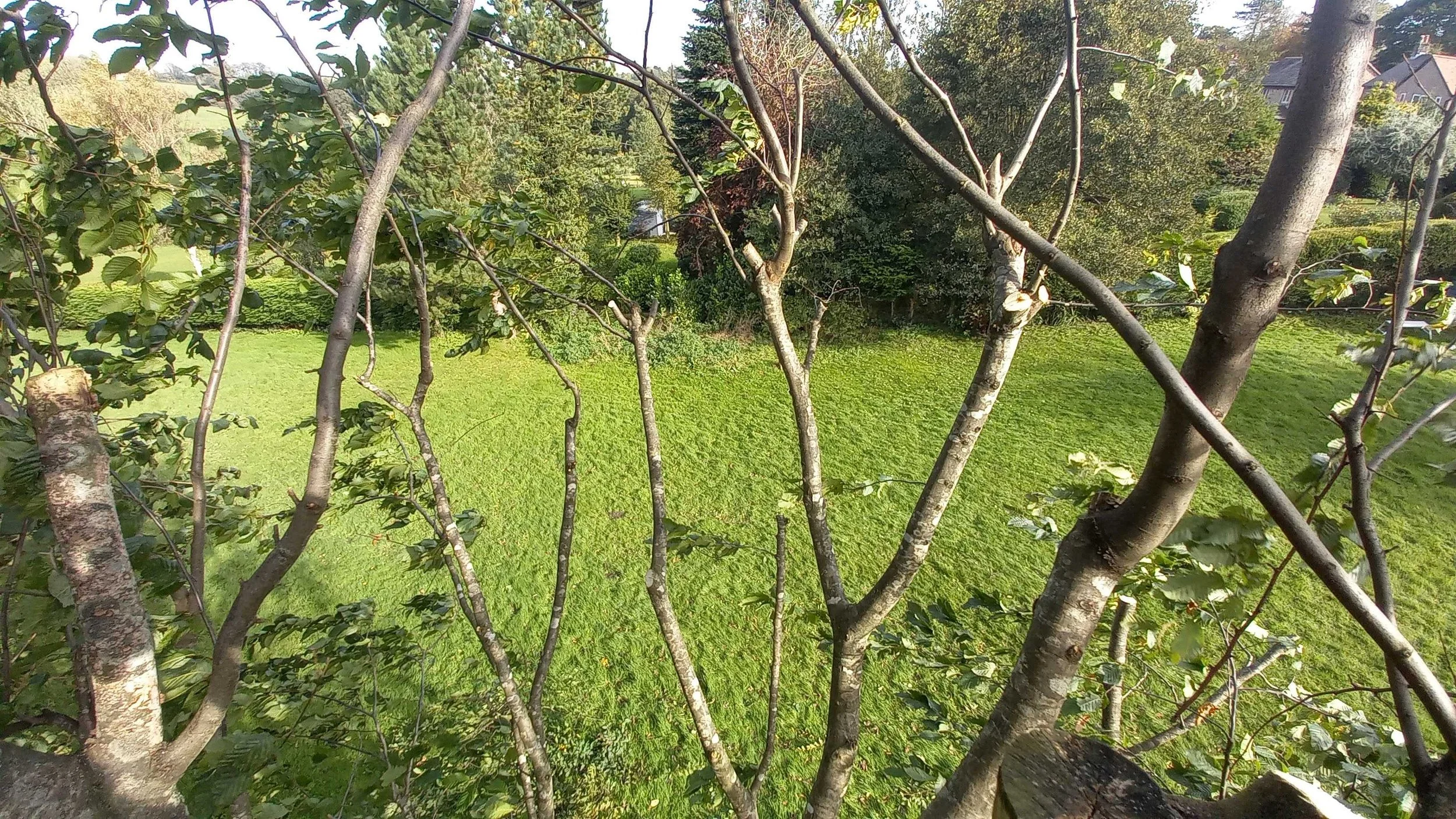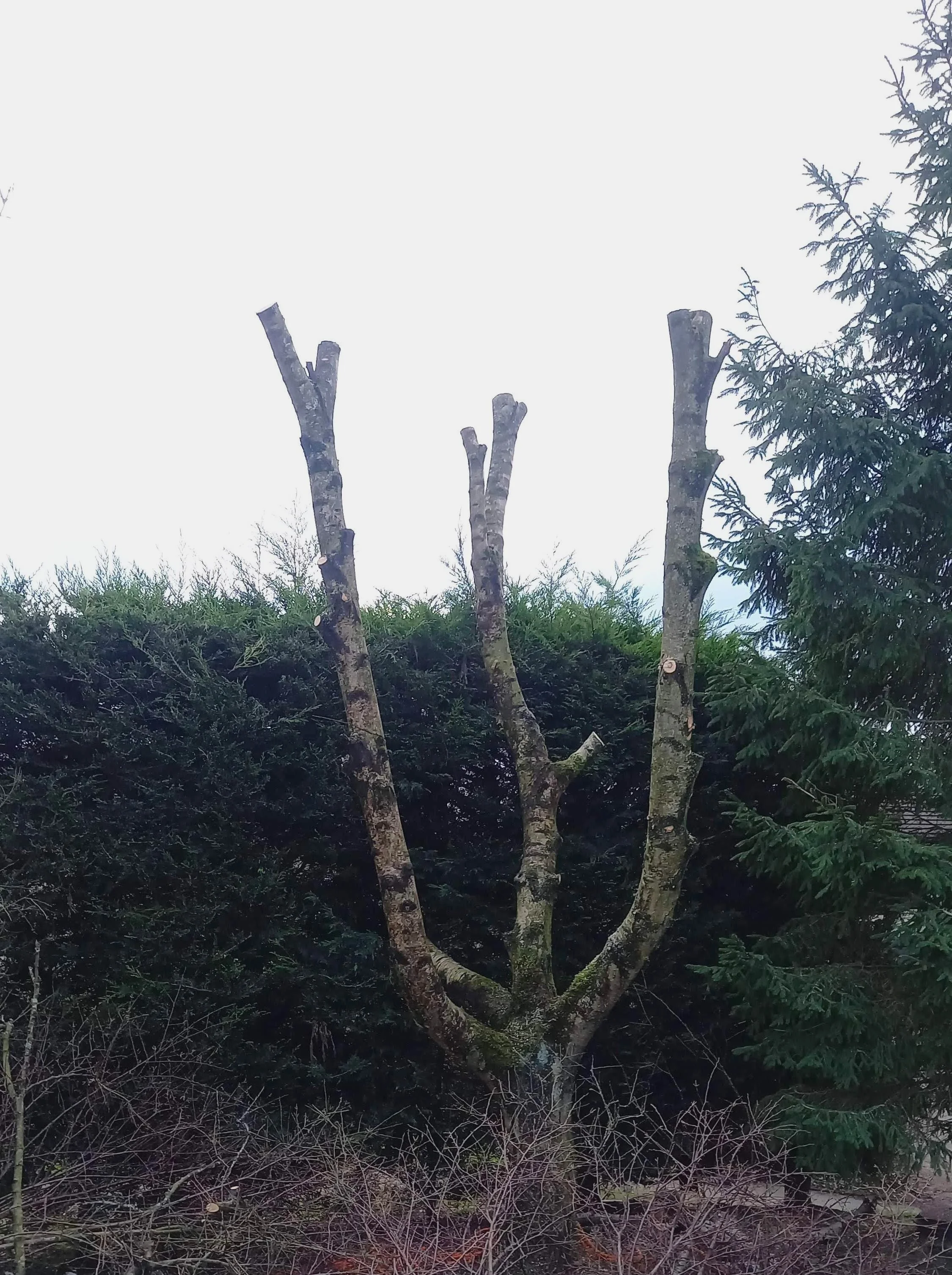Tree Pruning vs Tree Pollarding
So there are many techniques a tree surgeon can use on a tree to either improve the overall health of a tree, reduce it in size for health or safety reasons or to make the tree more aesthetic. Two common techniques are Tree Pruning and Pollarding a Tree.
A Beech Tree Pruned in Chapel-en-le-frith, High Peak to reduce the size and allow more light onto the front of the property.
Tree Pruning
Pruning a tree involves selectively removing specific branches or parts of a tree. The primary objectives of pruning are to enhance the tree's health, improve its structure, and manage its growth. Here are some common purposes of pruning a tree:
Promoting Health:
Remove Dead or Diseased Branches: Pruning helps eliminate dead or diseased branches, preventing the spread of diseases and promoting overall tree health.
Reduce Insect Infestations: Removing infested branches can help control insect populations and minimize the impact of pests on the tree.
Improving Structure:
Thinning: Thinning involves selectively removing branches to increase air circulation and sunlight penetration, reducing the risk of disease and promoting even growth.
Reducing Crown Density: Pruning can open up the tree's crown, reducing density and preventing the development of weak, crowded branches.
Enhancing Appearance:
Shaping: Pruning can be done to shape the tree for aesthetic purposes, maintaining a pleasing and balanced form.
Managing Growth:
Controlling Size: Regular pruning can help manage the size of a tree, preventing it from becoming too large for its location.
Directing Growth: Pruning can guide the tree's growth by directing energy to specific branches or areas, shaping it according to desired characteristics.
Safety:
Removing Hazardous Branches: Pruning can eliminate branches that pose a safety risk, such as those overhanging buildings, sidewalks, or roads.
Fruit Production:
Stimulating Fruit Production: Fruit trees may benefit from pruning to remove excess growth, encourage fruiting wood, and improve the quality of the fruit produced.
Rejuvenation:
Encouraging New Growth: Pruning can rejuvenate older trees by encouraging the development of new, healthy growth.
It's important to note that improper pruning can harm a tree, so it's recommended to follow proper techniques and guidelines. Consulting with a professional arborist or tree care specialist (like myself) can help ensure that pruning is done correctly and in the best interest of the tree's health and longevity.
A diseased Birch Tree which needed pollarding in Chinley, High Peak
Tree Pollarding
Pollarding is a pruning technique that involves cutting back the upper branches of a tree to promote a dense head of foliage and branches. This method is usually performed on specific tree species for various purposes. Here are some common reasons for pollarding a tree:
Size Control:
Urban Environments: Pollarding is often employed in urban or confined spaces to control the size of trees. By regularly cutting back branches, the tree can be maintained at a manageable size.
Aesthetic Purposes:
Ornamental Gardens: Pollarding is used to achieve a specific, often formal, aesthetic in ornamental gardens and landscapes. The resulting dense canopy of foliage can create a unique and visually appealing shape.
Harvesting Wood:
Wood Production: Historically, pollarding has been used as a sustainable method of wood production. The regrowth from pollarded trees provides a regular supply of smaller branches and twigs that can be harvested for various purposes, such as firewood, fodder, or crafting.
Preventing Nuisance:
Utility Lines and Infrastructure: Pollarding is sometimes employed near utility lines or infrastructure to prevent interference and to maintain a safe distance between the tree and these structures.
Reducing Shade:
Allowing Light In: Pollarding can be used to reduce the amount of shade cast by a tree. This is particularly useful in situations where more sunlight is needed for the growth of other plants or for the well-being of adjacent structures.
Enhancing Longevity:
Managing Aging Trees: In some cases, pollarding is used as a technique to manage aging trees. By promoting vigorous regrowth, it can extend the lifespan of a tree that might otherwise decline with age.
Wildlife Habitat:
Encouraging Wildlife: Pollarded trees can create a unique habitat for certain wildlife species. The dense, regrown branches provide shelter and nesting sites for birds and other animals.
It's important to note that not all tree species are suitable for pollarding, and the technique requires proper care and timing. Incorrectly performed pollarding can stress the tree and lead to issues such as decay and disease. As with any pruning method, it's advisable to consult with a knowledgeable arborist or tree care professional (such as Pineapple Garden Services) to determine if pollarding is appropriate for a particular tree species and situation.
Summary
Pollarding or pruning; which one is more suitable depends ultimately on the desired outcome, location, surroundings, health and species of tree. Tree pruning is less likely to have an adverse effect on the tree’s health and is therefore better to prune a tree earlier in its life and keep on top of the size and shape as opposed to letting it grow to large and pollarding being the only option. That said, some species such as willow respond well to pollarding and regular pollarding is common to create the sought after shape and look. Ash is another species which will bounce back well from pollarding.
I hope you found this blog informative, I aim on writing at least 10 this year and any ‘shares’ or comments on future content are greatly appreciated.


